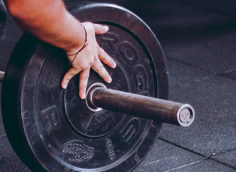Here's what you need to know...
- Determine your primary goal and a secondary goal that will complement it.
- Every program should include an upper-body push movement, an upper-body pull movement, a quad-dominant leg movement, and a hip-dominant leg movement.
- Decide on rep ranges and intensity that support your goals. For strength use 2-5 reps, for size and strength use 6-8 reps, and for hypertrophy shoot for around 10-12 reps.
- Pair exercises intelligently to reach goals and avoid injury.
Program design is one of the most butchered aspects of strength training. Here's how to create simple, effective plans that can be easily adjusted and replicated.
The overall objective of good workout design starts with setting realistic primary and secondary goals. First determine the primary goal of why you're training: either increase strength, gain size, or lose fat. Next, determine your secondary goal, which needs to enhance the primary goal.
For example, getting bigger is an excellent secondary goal to support a primary goal of getting stronger (or vice versa). If fat loss is your primary goal, your secondary goal could be increase work capacity, or look more muscular, or increase athleticism.
The important thing to remember is, determining your goals helps you choose appropriate sets, reps, and exercise pairing schemes.
Think in terms of a one-hour session. Start with a 5-minute warm-up, do a 40-minute workout, and end with a 15-minute period of specialized training that's highly sport or goal-specific.
- 2-5 workout sessions per week
- 60 minutes per session
- 5 minute warm-up
- 40 minute lifting portion
- 15 minute specialty portion
Adjust the length of any of these portions to fit your schedule as needed.
The specialty portion can also serve as a metabolic finisher, cooldown, or even used first as an extended warm-up. Specialty exercises might include:
- Metabolic conditioning
- Bodybuilding that targets lagging areas
- Sport-specific performance training
- Flexibility and mobility work
- Injury prehab/rehab work
- Grip training
Break down exercises into categories. You can train movements and body parts many different ways, so your list could certainly look different than this. You need categories to have a reproducible system.

The Big Four
The following four movements need to be in every program. If you're doing full-body workouts instead of body part splits or movement-based training programs, then they should be in every workout.
- Upper-Body Push. Movements in which the upper body is pushing or pressing an object away from the body or the body away from an object. Examples: Push-ups, bench presses, overhead presses, landmine presses.
- Upper-Body Pull. Movements in which the upper body pulls or rows an object toward the body or the body toward an object. Examples: Chin-ups, all kinds of rows, rope climbs.
- Quad-Dominant Leg. Movements involving significant knee flexion that primarily work the quads, glutes, and hamstrings. Examples: Squats, lunges, split squats, step-ups, vertical jumps.
- Hip-Dominant Leg. Hip-hinging movements that primarily work the posterior chain – the low back, glutes, and hamstrings. Examples: Deadlifts and all variations, glute-ham raise, hip thrusts, sprints, broad jumps.

The Not Quite As Big 1-4 Movements
Some of these should be in every workout, and ought to be in every week.
- Core. Exercises that target the abs and obliques. Examples: Crunches, planks, hanging knee-ups.
- Grip. Something that taxes the hands and forearms in a significant way. Examples: farmer walks, wrist curls, grippers, hanging holds, thick-grip exercises.
- Rotator Cuff. Thanks to desking, texting, and Tindering, the average person has terrible posture. Rotator cuff work should be included in every program to strengthen the rotator cuff and upper back. Examples: Face pulls, prone Y-T-L raises, pull-aparts.
- Lateral Hip. Weak lateral hips can be a precursor to injury by altering movement mechanics. Examples: Lateral lunges, mini-band walks, monster walks, lateral hip extensions.
Most programs will contain 3 or 4 of the following intensities or rep ranges, all of which will correspond to the three main goals in step one (strength, size, fat loss). An undulating rep scheme produces consistently strong results, so this undulation should be found within a workout and/or week.
Heavy: 2-5 Reps
Primarily builds strength. This range is appropriate for more advanced lifters who have a solid base of training and who want to get really strong on their big lifts.
Midrange: 6-8 Reps
Builds a mix of strength and size. This rep range should be included for all core lifts as a main builder of both size and strength, and as the primary strength builder for those just starting to train.
Hypertrophy: 10-12 Reps
Primarily builds muscle size, and may build strength in the higher rep ranges. Include this to create more time under tension which will build a foundation of muscle size and stamina. This is the range in which most bodybuilding exercises will fall.
Explosive
Builds strength and facilitates fat loss. It's important to include exercises that force a person to move fast in each workout.
Regular life doesn't force us to move quickly, unless perhaps we disturb a beehive while strolling to work. Examples include sprints, jumps, Olympic lifts, and medicine ball throws.
Conditioning
Burns fat and increases work capacity. Conditioning exercises are your means of facilitating fat loss – effective coupled together or even on their own.
Choose exercises that are safely performed at a high-intensity for 20-60 seconds. Examples of this type of work include mountain climbers, burpees, battling ropes, sprints, and sled pushes.
Pairing Rep Ranges
Pair exercises that push you toward the goal. Use active rest principles to maximize both time and training effects. Do super sets or triple sets while one exercise acts as "rest" for another.
It'll take some time to find which ones pair up best, and good pairings will change based on your goals.
Pairings for each goal:
- Goal: Strength
- Heavy rep ranges + Hypertrophy rep ranges
- Heavy rep ranges + Explosive rep ranges
- Midrange rep ranges + Midrange rep ranges
- Heavy rep ranges with no pairing
- Goal: Size
- Midrange rep ranges + Midrange rep ranges
- Hypertrophy rep ranges + Midrange rep ranges
- Hypertrophy rep ranges + Hypertrophy rep ranges
- Goal: Fat Loss
- Hypertrophy rep ranges + Conditioning
- Conditioning + Conditioning
- Midrange rep ranges + Explosive reps
- Conditioning with no pairing

This takes some experience, but it's about monitoring appropriate workloads, interactions between exercises, and maintaining safe technique.
High-technique lifts and heavy weights are best suited for the advanced. Stay away from these pairings altogether, or pair with different muscle groups at low intensities so the heavy exercise gets rest and can be performed safely.
With accessory lifts, pairings are more lax and there's less risk with overlapping muscle groups.
Don't Combine:
- Similar muscle groups when a heavy or high-technique lift is used
- Two exercises that heavily tax the same joint
- An exercise that can cause cramping in another (hamstrings are a usual suspect)
- Exercises that both drastically elevate blood pressure
Do Combine:
- Dissimilar muscle groups
- Similar muscle groups for hypertrophy goals
- High-technique with low-technique lifts
- Exercises with different force vectors
Good Example:
- A1 Front Squats: 4 x 5
- A2 Chin-Ups: 4 x 12
The chin-ups primarily work the arms and back, which provides a respite for the legs, lower back, and core after a set of front squats.
Bad Example:
- A1 Front Squat: 4 x 5
- A2 Barbell Row: 4 x 12
The barbell row works the arms and back just like the chin-up, but the lower back is forced to work hard in both exercises. This pairing is likely to cause low back pain before starting the third set.

Now assemble the workout. This is a 7-exercise format, containing two pairs, one triple-set (if size is the main goal), and two specialty exercises at the end in all the examples – except the one with strength as the main goal.
Goal: Strength
- Stick to heavy and midrange reps
- Add hypertrophy accessory lifts to build supportive muscle
- Perform prehab exercises to stay healthy
- Add explosive exercises that help you move weight faster
Sample Workout
| Category - Rep Range | Exercise | Set / Rep | |
|---|---|---|---|
| A1 | Upper Body Push - Heavy | Bench Press | 4 x 5 |
| A2 | Upper Body Pull - Hypertrophy | 1-Arm Cable Row | 3 x 12/arm |
| B1 | Hip-Dominant Leg - Heavy | Deadlift | 4 x 5 |
| B2 | Explosive Leg - Explosive | Broad Jump | 4 x 12 |
| C1 | Quad-Dominant Leg - Midrange | Front Squat | 3 x 8 |
| C2 | Core - Hypertrophy | Hanging Leg Raise | 3 x 12 |
| Specialty | |||
| D | Lateral Hip - Hypertrophy | Clamshells | 2-3 x 15 |
| E | Grip - Hypertrophy | Farmers Walk | 2-3 x 90 sec. |
Goal: Size
- Stick to the 6-8 and 10-12 rep ranges
- Pair similar muscle groups to induce a pump
- Don't worry too much about explosive or conditioning exercises
Sample Workout
| Category - Rep Range | Exercise | Set / Rep | |
|---|---|---|---|
| A1 | Upper Body Pull - Midrange | Chin-Up | 3 x 12 |
| A2 | Upper Body Push - Hypertrophy | Bench Press | 3 x 12 |
| B1 | Quad-Dominant Leg - Midrange | Front Squat | 4 x 6-8 |
| B2 | Upper Body Push - Hypertrophy | Overhead Press | 3 x 12 |
| C1 | Hip-Dominant Leg - Hypertrophy | Barbell Hip Thrust | 3 x 12 |
| C2 | Upper Body Pull - Hypertrophy | Chest Supported Row | 3 x 12 |
| C3 | Rotator Cuff - Hypertrophy | Pull-Apart | 3 x 12 |
| Specialty | |||
| D | Core - Hypertrophy | Reverse Crunch | 3 x 60 sec. |
| E | Grip - Hypertrophy | Wrist Curls | 3 x 60 sec. |
Goal: Fat Loss
- Keep the heart rate elevated
- Build a little muscle
- Extend the warm-up to make it more cardiovascular and metabolic
- Pair conditioning exercises with exercises in the 6+ rep range
Sample Workout
| Category - Rep Range | Exercise | Set / Rep | |
|---|---|---|---|
| Extended Warm up | Sprint Suicides | 15 min. | |
| A1 | Upper Body Push - Hypertrophy | Push Ups | 3 x 12 |
| A2 | Conditioning | Sled Push | 3 x 60 sec. |
| B1 | Hip-Dominant Leg - Hypertrophy | Hip Thrust | 3 x 12 |
| B2 | Conditioning | Battling Ropes | 3 x 30 sec. |
| C1 | Quad-Dominant Leg - Hypertrophy | Goblet Squat | 3 x 12 |
| C2 | Upper Body Pull - Hypertrophy | Chin-Up | 3 x 12 |
| Specialty | |||
| D | Rotator Cuff - Hypertrophy | Prone L Raise | 3 x 15 |
| E | Mobility | Foam Rolling | 3 min. |

1. Workout is Too Long
Shorter, more intense workouts are better than longer workouts. After 40 minutes of hard work, the quality of the session rapidly degrades. Everybody's different, but 90-minute workouts are almost always too long.
2. Failing to Create Balance
This is often overlooked. For relative balance and symmetry among the muscle groups, shoot for:
At least 1:1, preferably 2:1, ratio of hip-dominant to quad-dominant exercises
At least 1:1, preferably 2:1, ratio of pulling to pushing exercises
In each workout, include at least one of the following movements:
- Rotator cuff work
- Mobility work
- Explosive work
If you use isolation exercises, make sure to hit antagonist muscles as well. Get those biceps and triceps.
3. Believing More Variety is Better
Doing more sets of fewer exercises will improve technique and strength faster than choosing a little of everything. Err on the side of fewer exercises. There isn't enough energy to go around when it's spread over so many exercises.
4. Obsessing Over Percentages
Percentages help mostly in defining goal weights or starting weights. For instance, you often hear this question:
"I've been squatting 285 for 5 reps. How much should I be able to do for 10 reps?"
Percentages help you find an answer, but day-to-day strength and intensity will vary. Specifying weights or percentages ahead of time prevents the lifter from finding the correct weight for a given day – he may be stronger or weaker than the listed percentage.
Instead, use percentages to ballpark starting weights or to map out a workout, but realize it's okay to stray from them.
5. Obsessing Over Tempo
Complicated tempos (like 3031) often leads to confusion. And that's the last thing you need when there's a bar on your back. Try this instead:
- For reps below 8: Move the weight up fast, control it on the way down.
- For reps of 8 and above: Move the weight fast, count to three on the way down.
Below 8 reps, you're building strength and power, so move quickly but under control. Above 8 reps, you're building muscle size, so lengthen the time under tension.
Program-writing improves with practice and self-knowledge. The sooner you start, the sooner you'll master it, and eventually master your goals.





